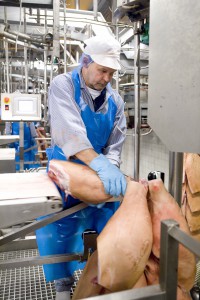 The world’s second largest meat processor, Danish Crown, is pursuing a growth strategy and sees many opportunities in the future, despite its high cost structure, the company’s Chief Analyst, Karl Christian Møller, told delegates at Alberta Pork’s AGM last December. A focus on increasing the value-added component of its business, forging supply chain partnerships with retailers and an expansion of localized production in other European countries is the key to future success, he says. The cooperative company, owned by its 13,000 supplying producers, has recently agreed the purchase of companies in Sweden, Slovakia and Britain. “These local activities are increasing the most, because they have lower production costs,” Møller explained. “We have purchased high quality companies, with good management, who know the local market well, so we can tailor our products to local needs.”
The world’s second largest meat processor, Danish Crown, is pursuing a growth strategy and sees many opportunities in the future, despite its high cost structure, the company’s Chief Analyst, Karl Christian Møller, told delegates at Alberta Pork’s AGM last December. A focus on increasing the value-added component of its business, forging supply chain partnerships with retailers and an expansion of localized production in other European countries is the key to future success, he says. The cooperative company, owned by its 13,000 supplying producers, has recently agreed the purchase of companies in Sweden, Slovakia and Britain. “These local activities are increasing the most, because they have lower production costs,” Møller explained. “We have purchased high quality companies, with good management, who know the local market well, so we can tailor our products to local needs.”
 High costs are the albatross around the necks of both Danish producers and the processing sector. Producers have to meet stringent environmental and welfare regulations and also have high feed and labour costs. “The price of wheat is now $382/tonne and producers aren’t able to purchase corn from the USA due to a ban on GMO crop imports into the EU,” Møller pointed out. “Producers are now losing $45 per hog.” Danish Crown’s average cost of employing people working in their plants is $43/hour, compared with a figure of $10-15 in Germany, where processors employ workers from Eastern Europe. In response, the company has rationalized its operations from 20 to 10 plants, maximized the use of automation and increased capacity utilization. A new plant at Horsens, Jutland, which opened in 2005, slaughters 90,000 pigs per week with a two-shift system and a staff of only 1300.
High costs are the albatross around the necks of both Danish producers and the processing sector. Producers have to meet stringent environmental and welfare regulations and also have high feed and labour costs. “The price of wheat is now $382/tonne and producers aren’t able to purchase corn from the USA due to a ban on GMO crop imports into the EU,” Møller pointed out. “Producers are now losing $45 per hog.” Danish Crown’s average cost of employing people working in their plants is $43/hour, compared with a figure of $10-15 in Germany, where processors employ workers from Eastern Europe. In response, the company has rationalized its operations from 20 to 10 plants, maximized the use of automation and increased capacity utilization. A new plant at Horsens, Jutland, which opened in 2005, slaughters 90,000 pigs per week with a two-shift system and a staff of only 1300.
Møller sees opportunities both in the “old” EU countries and in the new member countries. “After 1990, meat consumption in the Central European countries fell by 40-60%,” he noted. “There is a big demand for pork and consumption is rising as incomes increase.” Because labour is relatively cheap, further processing in these countries is profitable. “Also, the retail structure is changing away from butchers’ shops to larger retailers that want to source meat from vet-inspected modern plants,” Møller said.
In Western Europe, customer focus is on convenience, food variety, safety, animal welfare and impact on the environment. Incomes are high and the demands on food producers reflect that. “Many consumers have a zero attitude to risk and yet, at the same time, they go to the discount supermarket to buy meat as cheaply as possible!” Møller exclaimed. Countries that have set high standards for safety or welfare offer an opportunity to sell at higher prices, he said. “Sweden has a zero- Salmonella policy so pork prices are very high because there are few imports.” In the UK, where the Danes have been exporting bacon for 150 years, prices are 30% higher than in Denmark due to high welfare standards, such as a requirement for group housed sows. Danish Crown owns 40,000 outdoor-housed sows in Eastern England and its Tulip Foods subsidiary accounts for 32% of the company’s total turnover. It has recently purchased George Adams, a company that processes 15,000 pigs per week, carries out a high degree of further processing and turns over $350 million per year. Danish producers also provide pigs for the UK market, produced to UK standards, for which they are paid a premium of 10 cents/kg.
In high-income countries, demand for organic pork is increasing rapidly and Danish Crown subsidiary Friland is one of the leading suppliers. “Producers get paid around three times the normal price and their production cost is about double, so it’s very profitable for them,” Møller noted.
The Danish cooperative model could provide a model for Canadian producers in the future, Møller feels, allowing them to capture some of the added value created in the supply chain. Danish producers build up equity in the company through a “Personal Capital Account” by paying 1.5% of the value of pigs sold and producer equity is $1bn of the total $4bn company equity. “Although they get their money back when they leave the company, they have to give one year’s notice because a stable supply of pigs is essential,” Møller stressed. The hog price is set by taking the total value of product sold in the global marketplace and deducting processing costs. After the year-end, producers receive a bonus, giving a return on their investment, which for 2006-7 was 15 cents per kilo for market hogs.
Asked if his company had any interest in owning a plant in Canada, Møller said that EU markets were much more profitable. “It’s better to be in a place where production is declining and demand is increasing,” he explained. “However, as competitors with Canada in world export markets, Danish producers think that Canadian producers have many advantages such as lower feed costs and space to produce pigs, so they do fear you as competitors.”
Photo captions:
- Karl Moller-1.jpg: Karl Christian Møller, Senior Analyst with Danish Crown
- Danish processing-1.jpg: Value added processing is the key to Danish Crown’s success. (Photo courtesy Danish Bacon and Meat Council)









